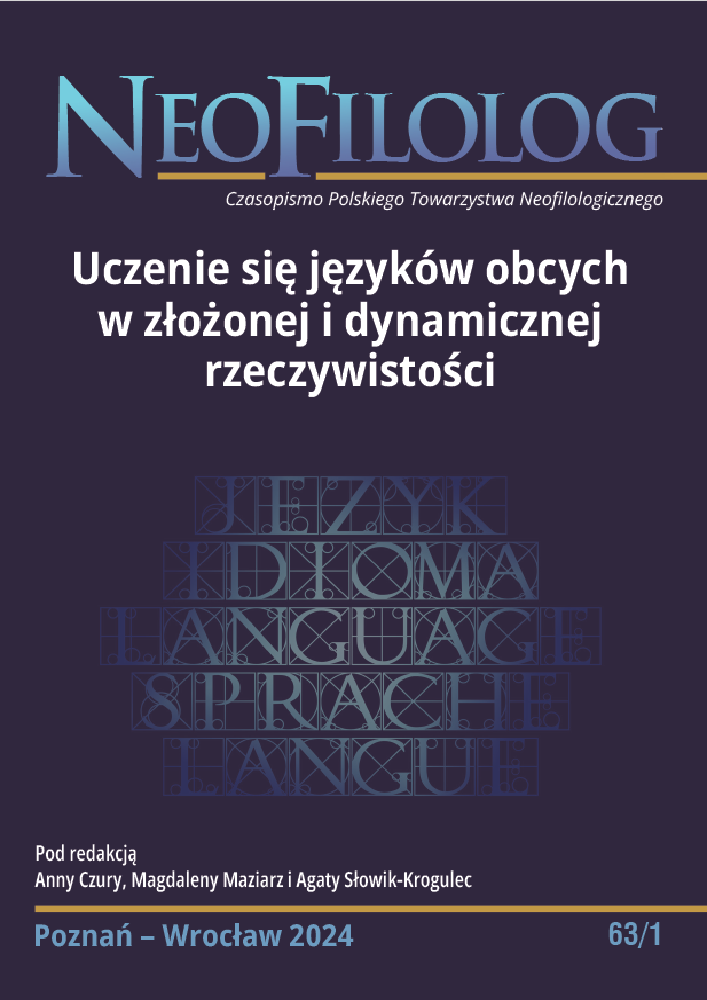Résumé
Lexical competence of teenage heritage and native users of Polish has never been the subject of a comprehensive comparison. The first extensive empirical data were gathered by the Jagiellonian University research team in the project Heritage and native language – a comparison of language competences of teenage Polish and heritage learners. In the first stage of the present study, vocabulary tests of the two groups were analyzed. The results showed few differences in receptive knowledge, but in productive knowledge heritage users lagged behind. Therefore, in the second stage, selected essays were compared in terms of their vocabulary profiles. It was found that native and heritage language users’ lexical profiles differ markedly, to the considerable disadvantage of heritage users. Polish educators responsible for the schooling of migrant children must be aware of this, as too often heritage speakers who enter home schools after (re)immigration are treated as if there were native users. This however, as this research has clearly shown, is by no means the case.
Références
Aitchison J. (1994), Words in the Mind. Oxford: Blackwell.
Cummins J. (2000), BICS and CALP, (w:) M. Byram (red.), Routledge Encyclopedia of Language Teaching and Learning. New York: Routledge, s. 76–79.
ESOKJ (2003): Europejski system opisu kształcenia językowego: uczenie się, nauczanie, ocenianie. Warszawa: Wydawnictwo CODN.
Fishman J.A. (2001), 300-Plus Years of Heritage Language Education in the United States, (w:) Kreeft Peyton J., Ranard D.A., McGinnis S. (red.), Heritage Languages in America. Preserving a National Resource. Washington, DC & McHenry, IL: Center for Applied Linguistics & Delta Systems, s. 81–99.
Janowska I. i in. (2011), Programy nauczania języka polskiego jako obcego. Poziomy A1 – C2. Kraków: Księgarnia Akademicka.
Kielar-Turska M. (1989), Mowa dziecka. Słowo i tekst. Kraków: Wydawnictwo Uniwersytetu Jagiellońskiego.
Laufer B (1991), The development of L2 lexis in the expression of the advanced language learner. „Modern Language Journal”, nr 75, s. 440–448. DOI: https://doi.org/10.1111/j.1540-4781.1991.tb05380.x
Laufer B., Nation I.S.P (1995), Vocabulary size and use: lexical richness in L2 written Production. „Applied Linguistics”, nr 16(3), s. 307–322. DOI: https://doi.org/10.1093/applin/16.3.307
Lipińska E. (2003), Język ojczysty, język obcy, język drugi. Wstęp do badań dwujęzyczności. Kraków: Wydawnictwo Uniwersytetu Jagiellońskiego.
Lipińska E., Seretny A. (2012), Między językiem ojczystym a obcym. Nauczanie i uczenie się języka odziedziczonego w chicagowskiej diasporze polonijnej. Kraków: Księgarnia Akademicka.
Lipińska E., Seretny A. (2016), Język odziedziczony – polszczyzna pokoleń polonijnych. „Poradnik Językowy”, nr 10, s. 45–61.
Lipińska E., Seretny A. (2022), Nauczanie języka przez literaturę, a literatury przez język – o metodzie skorelowanej w pracy z uczniami polonijnymi. „Filologia Polska. Roczniki Uniwersytetu Zielonogórskiego”, nr 8, s. 19–36. DOI: https://doi.org/10.34768/fp2022a1
Martyniuk W. (2015), Edukacyjna sprawność językowa w ujęciu działaniowym Rady Europy. „LingVaria”, nr 2, s. 69–79. DOI: https://doi.org/10.12797/LV.10.2015.20.06
Montrul S. (2016), The Acquisition of Heritage Language. Cambridge: Cambridge University Press.
Pamuła-Behrens M. (2018), Język edukacji szkolnej w integracyjnym modelu wsparcia ucznia z doświadczeniem migracji w rodzinie. „Postscriptum Polonistyczne”, nr 2(22), s.171–186. DOI: https://doi.org/10.31261/PS_P.2018.22.11
Richards J. (1976), The Role of Vocabulary Teaching. „TESOL Quarterly”, nr 1, s. 77–90. DOI: https://doi.org/10.2307/3585941
Schleppegrell M.J. (2004), The Language of Schooling: A Functional Linguistics Perspective. Mahwah, NJ: Erlbaum. DOI: https://doi.org/10.4324/9781410610317
Seretny A. (2011), Kompetencja leksykalna uczących się języka polskiego jako ankietowa w świetle badań ilościowych. Kraków: Universitas.
Seretny A. (2021), Polszczyzna w szkole, czyli język jako narzędzie poznania, (w:) Seretny A., Lipińska E. (red.), Dydaktyka języka polskiego jako nierodzimego. Konteksty – dylematy – trendy. Kraków: Universitas, s. 113–140.
Seretny A. (2022), Polszczyzna jako język drugi w szkole. Wymagania leksykalne komunikacyjnej i edukacyjnej odmiany języka, „Neofilolog”, nr 58(1), s. 98–118. DOI: https://doi.org/10.14746/n.2022.58.1.7
Seretny A., Lipińska E. (2023), Kompetencje uczniów w zakresie języka polskiego jako odziedziczonego i jako ojczystego w ujęciu komparatywnym – podsumowanie projektu badawczego. „Acta Universistais Lodziensis. Kształcenie Polonistyczne Cudzoziemców”, nr 30, s. 293–303. DOI: https://doi.org/10.18778/0860-6587.30.18
Synowiec H. (1995), Rozwój słownictwa nazywającego cechy osobowości w języku dzieci i młodzieży. Katowice: Wydawnictwo Uniwersytetu Śląskiego.
Snow C. (1993), Literacy and language: Relationships during the preschool years. „Harvard Educational Review”, nr 53, s. 165–189. DOI: https://doi.org/10.17763/haer.53.2.t6177w39817w2861
Zarębina M. (1965), Kształtowanie się systemu językowego dziecka. Wrocław: Zakład Narodowy im. Ossolińskich.
Licence
© Anna Seretny 2024

Ce travail est disponible sous licence Creative Commons Attribution - Pas de Modification 4.0 International.
Auteurs :
Les auteurs de textes acceptés pour publication dans la revue Neofilolog sont tenus de remplir, signer et renvoyer à l'adresse de la rédaction, un accord sur l'octroi d'une licence gratuite pour les œuvres, avec obligation d'accorder une sous-licence CC.
En vertu de cet accord, les auteurs des textes publiés dans la revue Neofilolog accordent à l'Université Adam Mickiewicz de Poznań une licence non exclusive et gratuite et permettent l'utilisation de la sous-licence Creative Commons Attribution-NoDerivatives 4.0 International (CC BY-ND 4.0).
Les auteurs se réservent le droit de disposer librement de l'œuvre.
Utilisateurs :
Les utilisateurs d'Internet intéressés ont le droit d'utiliser les œuvres publiées à partir de l'année 2017 sous réserve des conditions suivantes :
- reconnaissance de la qualité d'auteur - l'obligation de fournir des informations sur la qualité d'auteur, le titre, la source (liens vers l'œuvre originale, DOI) et la licence, ainsi que l'œuvre distribuée ;
- sans créer d'œuvres dérivées - l'œuvre doit être conservée dans sa forme originale, p. ex. les traductions ou les interprétations ne peuvent être distribuées sans le consentement de l'auteur.
Tous les textes publiés sont soumis au droit d'auteur.
Autres :
L'Université Adam Mickiewicz de Poznań se réserve le droit à la revue dans son ensemble (mise en page, forme graphique, titre, conception de la couverture, logo, etc.).
.

